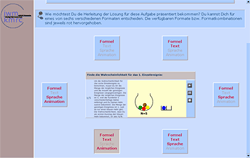April 2007 - March 2009
German Research Foundation (Deutsche Forschungsgemeinschaft), NWO
This project focused on the transferability of well established multimedia
design principles to hypermedia and on the question of an optimal design and
utilization of hypermedia learning environments. The project was part of a Dutch-German
research cooperation on "Affordances for learning in multimedia learning
environments" which is funded by NWO and DFG and is carried out together
with the universities of Freiburg, Heerlen (NL), and Twente (NL). A main focus
in this project was on the question how the aforementioned multimedia principles
(e.g., Ainsworth, 1999; Mayer, 2001) can be used to inform the design of hypermedia
learning environments. Additionally, individual information utilization strategies
(effectiveness of different information diets for different learners, adaptive
utilization strategies) are taken into account.
Learning materials are hypermedia environments that aim at conveying basic principles
of probability theory by means of worked examples. The solution steps described
in these examples can be presented in a purely arithmetical format or enriched
with textual elaborations (visual, auditory) and/or with interactive animations.
In this way, the hypermedia environments used in this project enable an integration
of information units that differ with regard to their representational codes
as well as with regard to their sensory modalities.
Results of completed studies in this project show that multimedia design principles cannot simply be transferred to hypermedia, that learners do not necessarily benefit from a high amount of learner control but that they get along better with a more structured environment, and that they do not use the freedom provided with regard to navigational and representational choices in an optimal way. A follow-up study thus investigated how much structure hypermedia environments should offer to foster efficient learning and avoid cognitive overload. Three versions of the learning environment were compared with each other, each of them providing a different level of learner control. It was shown that the most effective learning takes place under strict system control, that is, in a learning environment that guides learners through the contents.
To further investigate the question whether this superiority of system controlled
environments can be put into perspective if differences in individual characteristics
between learners are considered; an associated dissertation project investigated
the benefit of different forms of instructional support in general and for learners
differing with regard to their epistemological beliefs, attitudes towards mathematics
and computers, and metacognitive abilities and strategies. Instructional support
refers to the comparison of learning environments that provide metacognitive
modeling and/or prompting of representational awareness with environments that
do not provide such support forms.

Fig. 2: Support of representational choice: Before deciding for one of the representational formats, learners can retrieve example screenshots and listen to advantages and disadvantages of the respective examples.